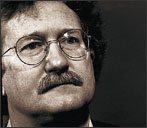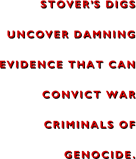

ERIC STOVER
After more than a decade spent peering into mass graves and documenting war crimes, Eric Stover, a writer and director of UC Berkeley's Human Rights Center, often uses the word "hell" to describe the human carnage he has seen.
"A heavy rain had turned the grave into a brown soup of arms and legs," he wrote about one Bosnian grave excavation, "and as the exhausted workers lifted the remains from the mud, their boots made a loud sucking sound like a toilet plunger. Occasionally, workers would slip and fall onto the pile of corpses, shouting for help as they clung desperately to the decaying, eel-like appendages and spat out mud and tufts of hair."
Stover's tidy Berkeley office, its window overlooking the tranquil greenery of Faculty Glade, is thousands of miles from that horrifying scene. But the 46-year-old adjunct professor of public health remains haunted by the image -- and hundreds of others.
"It was a pig farm, and the stench of decaying bodies mixed with the smell of the manure was hell," Stover said, in a monotone voice, speaking again of the 1996 Bosnian dig. It was at a farm there that hundreds of Bosnian Muslim prisoners, ranging from teenage boys to men in their sixties and seventies, were lined up in a cornfield and shot.
Stover's face is thin -- a bout of hepatitis felled him for many months after his last Bosnian dig, two years ago. Otherwise, with boyish curls and a gentle demeanor, he shows little sign of his 15 years on the battlefield documenting war crimes from Eastern Europe's Srebrenica and Vukovar -- subjects of his most recent book, "The Graves" -- to Rwanda, Cambodia, Argentina and Brazil.
The evidence that Stover and his colleagues collect overseas is helping in a number of war crime trials on several continents.
Much of Stover's recent work in the Balkans was sponsored by the International Criminal Tribunal for the former Yugoslavia and Physicians for Human Rights. Stover's reports on the massacres at Vukovar in 1991 helped bring about arrest warrants for four Serbian military officers. One hung himself in detention, the other three remain at large.
But bringing criminals to justice is only one of Stover's objectives.
"I especially want to help the families of the victims," he said. "Many of the survivors are caught in a limbo between hope and grief. They can neither return to their past lives nor plan for the future until they know the fate of their loved ones. They are consumed by the need to know the truth, to know what exactly happened and to recover the bodies for a proper burial."
Finding graves is a challenge. Sometimes satellite photos are helpful, showing areas where the earth recently was disturbed. More often, Stover and his teams interview villagers who witnessed or heard of massacres.
Among the rolling hills of Bosnian farmlands, the teams of forensic anthropologists and medical students trained to exhume and identify bodies begin their grisly and physically exhausting search for evidence.
They are looking for fresh graves -- large and small -- where human bones, bullets, artifacts and personal effects give clues about the cause and manner of death, as well as the identity of the nameless victims.
The forensic teams move in on suspected sites, usually after the areas are cleared of land mines. They sweep the site with metal detectors to find bullet casings and then move across it on hands and knees for fear of disturbing evidence, tearing out all vegetation.
When the land is bare, they look for sunken soil where the ground recently has collapsed or places where the earth is a different color from that around it.
Once a grave is found, bodies are uncovered very carefully using hand trowels and brushes -- the same tools archaeologists use to excavate ancient ruins. Some workers even use chopsticks or dental picks.
Since the human body has 206 bones, Stover said, it's painstaking work. Bones are taken out one-by-one and bagged. All the finger bones from one skeleton go together in one sack, pelvic bones in another, and so forth. Finally, the remains are moved -- in vehicles ranging from Jeeps to semi-trailers -- to a nearby makeshift laboratory. In Bosnia, an abandoned garment factory was used.
Both the dig and the lab work can uncover damning evidence.
Single gunshot wounds to the head usually signal an execution-style killing, said Stover. If the wrists of the dead are bound together with wire, the victims likely were a group of defenseless, executed prisoners, not battlefield casualties. The position of bullet casings near a grave can reveal a firing line.
Killers' methods vary from country to country, said Stover.
"Murder has its own landscape," he said. "In the forests of the American South, racists hanged people from trees. In the plains of Poland, the Nazis didn't want to pollute the water supply, so they built furnaces. The mountainous terrain of Bosnia is good for hiding things, so they buried bodies below the ground."
Stover also interviews residents of nearby towns, since their knowledge of an alleged crime may shed light on the dig. But equally important is learning how genocide affects families and communities. Stover uses a tape recorder, takes notes, shoots photos.
He trains Berkeley graduate students to do this work as well. In the past year alone, the campus's human rights center -- established with funds from The Sandler Family Supporting Foundation -- has dispatched his students to work with human rights organizations in a dozen countries.
Also documenting the dead on some of Stover's trips is famous photographer Gilles Peress, whose photos of the carnage unearthed in Bosnia appear in "The Graves."
The book shows the minute detail -- the keys in a victim's pocket, the pattern of stripes on a man's trousers, a bullet's exact entry point on a leg bone, family snapshots unearthed with the dead -- that Stover seeks to paint the most accurate picture of genocide.
"Next to one of the bodies was a battered copy of the Koran, its pages stained with blood and caked in mud," Stover wrote, describing the grave of a Bosnian Muslim. "A few yards away, a small shaving mirror hung from a branch. And, on the ground below it, resting on a flat gray stone, was a straight razor rusted shut by the rain and snow."
Curiously, it's not man's worst atrocities but the good in people that Stover finds most moving.
"The families and the small grassroots human rights organizations we work with are so dedicated and courageous," he said. "They were there during the wars and the violence. They'll be there picking up the pieces for a long time after."
For more information on each professor, select from the following links:
- Eric Stover, who documents war crimes
- Beatriz Manz, who traces Guatemalan "disappeareds"
- Nancy Scheper-Hughes and Lawrence Cohen, who investigate "neo-cannibalism"
- Main Extreme Research page


[Table of Contents] [Berkeley Magazine Home] [UC Berkeley Home Page]
Copyright 2000, Regents of the University of California. All rights reserved.
Comments? E-mail ucbwww@pa.urel.berkeley.edu.